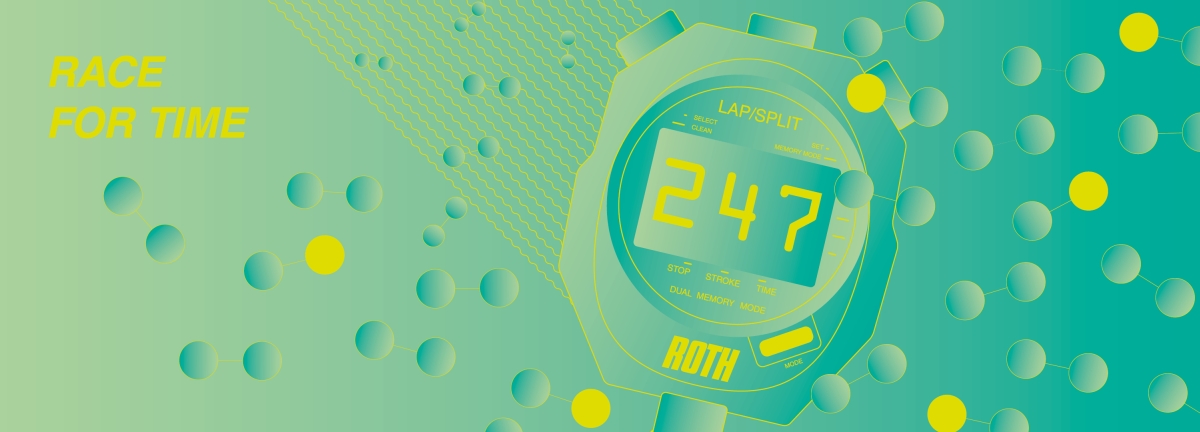
A race against time
The ability to pause time in the most beautiful of moments is a human longing that science will probably never fulfil.
However, a research team at Frankfurt’s Goethe University has come close in recording a micro-fragment of time in which practically no time has passed at all:
In 2020, the atom physicists led by Reinhard Dörner managed to record the shortest time span ever measured: 247 zeptoseconds. This is the current world record in short-time measurement.
How short is a zeptosecond? Here’s a breakdown:
247 zeptoseconds – that’s how long it takes a light particle to travel through a molecule of two hydrogen atoms at the speed of light. This span is so short that it escapes any human sense of time, and requires a great deal of context – as well as imagination – to fully comprehend:
A zeptosecond is a trillionth of a billionth of a second (10−21 s).
For comparison:
- 100: The human heart beats roughly every second.
- 10-3: A typical camera flashes in one millisecond.
- 10-6: A high-speed strobe light flickers every microsecond.
- 10-9: Modern computer processors calculate several tasks in a nanosecond.
- 10-12: · Eye pigments react to light in one picosecond.
- 10-15: The previously measured smallest unit of time, the femtosecond, is to the second what a second is to 32 million years.
But arguably, as soon as we start getting into the nanoseconds, the concept of time becomes completely abstract for us.
Hydrogen molecule and X-rays set “stopwatch world record”
The Egyptian chemist Ahmed Zewail won the Nobel Prize in 1999 for his advance into the era of the femtosecond.
For the current world record time measurement, the Frankfurt research team, together with Hamburg and Berlin colleagues at the German Electron Synchrotron (DESY, Hamburg), bombarded hydrogen molecules with X-rays. They used PETRA III (Positron-Electron Tandem Ring Facility), one of the brightest storage-ring-based X-ray sources in the world. The scientists adjusted the beam energy so that one photon was enough to push both electrons out of the hydrogen molecule (H2).
Interference patterns as a basis for calculation
By knocking out the electrons, electron waves formed around both hydrogen atoms, which overlapped. The researchers examined the resulting interference pattern under a specially developed reaction microscope called COLTRIMS (Cold Target Recoil Ion Momentum Spectroscopy).
Knowledge of the spatial orientation of the molecule was crucial. Combined with the interference pattern, the research team was able to precisely calculate when the light particle had reached the first hydrogen atom, and when it had reached the second.
The time gap between them was up to 247 zeptoseconds long. The actual measured time depended on how far apart the two atoms in the molecule were from the photon’s perspective.
Something to digest at a slower pace: A brief overview of the history of timekeeping
The human need to measure time has existed since antiquity. The practical necessity to measure time with increasing accuracy drove the technical development of measuring instruments. This progressed from elementary clocks powered by sun, water and candles, to spring and pendulum clocks, through to mechanical and electrical timepieces, and ultimately to atomic (nuclear) clocks.
From a scientific and research perspective, short-time measurement is particularly relevant. It enables rapid physical, chemical and biological processes to be investigated in great temporal detail. Thanks to this, it is possible to decipher processes in nature and the environment that are imperceptible to the eye. It is a key factor in driving technological innovation and gaining fundamental knowledge about our universe.
Zeptosecond – a quantum leap for technological progress?
Therefore, the world record for the zeptosecond is more than just a prestige win in the international competitive research. It has the potential to make short-time measurement and thus its areas of use and application even more precise:
For example, in the understanding of chemical and quantum mechanical processes, or when it comes to developing new technologies in the field of materials science and medicine, or investigating other previously unexplained physical phenomena in our world and in the universe.
Carl ROTH will help you keep track of time with clocks and timepieces of all kinds to equip your laboratory with. You can find these in the Carl ROTH Shop.
Sources:
https://www.science.org/doi/10.1126/science.abb9318
https://www.mpq.mpg.de/5388236/16-11-07-zeptosekunden-stoppuhr-fuer-den-mikrokosmos
https://de.wikipedia.org/wiki/Liste_von_Gr%C3%B6%C3%9Fenordnungen_der_Zeit
https://www.chemie.de/news/160494/eintritt-in-die-zeptosekunden-messung.html
https://winfuture.de/news,118918.html
https://www.desy.de/forschung/anlagen__projekte/petra_iii/index_ger.html

